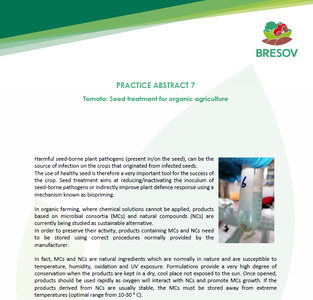{Tool} Tomato: Seed treatment for organic agriculture (BRESOV Practice Abstract). [Tomate: Saatgutbehandlung für den ökologischen Landbau (BRESOV Practice Abstract).] Creator(s): Branca, Ferdinando; Rizzo, Giulio Flavio and Lefebvre du Prey, Vincent. Issuing Organisation(s): University of Catania. (2022)
|
PDF
- Published Version
- English
994kB | |
![[thumbnail of 2022-11-02 16_50_08-BRESOV_Practice_Abstract_(7).pdf - Adobe Acrobat Reader DC.png]](/44539/2.hassmallThumbnailVersion/2022-11-02%2016_50_08-BRESOV_Practice_Abstract_%287%29.pdf%20-%20Adobe%20Acrobat%20Reader%20DC.png)  Preview |
Image (PNG)
- Cover Image
- English
168kB |
Document available online at: https://bresov.eu/publications/practice-abstracts
Summary
In fact, MCs and NCs are natural ingredients which are normally in nature and are susceptible to temperature, humidity, oxidation and UV exposure. Formulations provide a very high degree of conservation when the products are kept in a dry, cool place not exposed to the sun. Once opened, products should be used rapidly as oxygen will interact with NCs and promote MCs growth. If the products derived from NCs are usually stable, the MCs must be stored away from extreme temperatures (optimal range from 10-30 ° C). When using compounds such as MCs and NCs for an application on seeds, products should be diluted in water, at the doses recommended by the manufacturer. Seed dressing should be carried out by soaking the seeds in the MC suspension/NC solution. The recommended volume used is about 10 times the volume of seeds, in order to completely cover them. After 10 minutes shaking to ensure a uniform distribution, the seeds need to be left to dry on absorbent paper. It is recommended to sow the seeds within 24 hours of the seed dressing in order to maintain unaltered the NCs characteristics and MCs vitality during the first stages of germination.
Summary translation
MCs und NCs sind natürliche Inhaltsstoffe, die normalerweise in der Natur vorkommen und anfällig für Temperatur, Feuchtigkeit, Oxidation und UV-Einwirkung sind. Die Formulierungen bieten einen sehr hohen Grad an Konservierung, wenn die Produkte an einem trockenen, kühlen Ort aufbewahrt werden, der nicht der Sonne ausgesetzt ist. Nach dem Öffnen sollten die Produkte rasch verwendet werden, da Sauerstoff mit den NCs interagiert und das Wachstum von MCs fördert. Während die aus NCs hergestellten Produkte in der Regel stabil sind, müssen die MCs vor extremen Temperaturen geschützt werden (optimaler Bereich: 10-30 °C). Bei der Verwendung von Verbindungen wie MCs und NCs zur Anwendung auf Saatgut sollten die Produkte in Wasser verdünnt werden, und zwar in der vom Hersteller empfohlenen Dosierung. Die Saatgutbeizung sollte durch Einweichen der Samen in der MC-Suspension/NC-Lösung erfolgen. Das empfohlene Volumen beträgt etwa das 10-fache des Volumens der Samen, um sie vollständig zu bedecken. Nach 10 Minuten Schütteln, um eine gleichmäßige Verteilung zu gewährleisten, muss das Saatgut auf saugfähigem Papier trocknen. Es wird empfohlen, das Saatgut innerhalb von 24 Stunden nach der Beizung auszusäen, um die Eigenschaften der NCs und die Vitalität der MCs während der ersten Keimungsphasen unverändert zu erhalten.
| EPrint Type: | Practice tool |
|---|---|
| Teaser: | Learn about the importance of healthy seeds for the success of tomato crops. |
| What problem does the tool address?: | Harmful seed-borne plant pathogens (present in/on the seed), can be the source of infection on the crops that originated from infected seeds. The use of healthy seed is therefore a very important tool for the success of the crop. Seed treatment aims at reducing/inactivating the inoculum of seed-borne pathogens or indirectly improve plant defence response using a mechanism known as biopriming. |
| What solution does the tool offer?: | In organic farming, where chemical solutions cannot be applied, products based on microbial consortia (MCs) and natural compounds (NCs) are currently being studied as sustainable alternative. In order to preserve their activity, products containing MCs and NCs need to be stored using correct procedures normally provided by the manufacturer. |
| Country: | Spain |
| Type of Practice Tool: | Practice abstracts |
| Keywords: | seed health, disease control, disease prevention, seed storage |
| Agrovoc keywords: | Language Value URI English seed health http://aims.fao.org/aos/agrovoc/c_fad814e9 English plant disease control http://aims.fao.org/aos/agrovoc/c_5960 English disease prevention http://aims.fao.org/aos/agrovoc/c_10394 English seed storage http://aims.fao.org/aos/agrovoc/c_6938 |
| Subjects: | Crop husbandry > Production systems > Vegetables Crop husbandry > Breeding, genetics and propagation |
| Research affiliation: | European Union Italy > Univ. Catania UK |
| Horizon Europe or H2020 Grant Agreement Number: | 774244 |
| Related Links: | https://organic-farmknowledge.org/tool/44539, https://organic-farmknowledge.org/tool/40267, https://organic-farmknowledge.org/tool/44052, https://organic-farmknowledge.org/tool/39812, https://organic-farmknowledge.org/tool/37904 |
| Project ID: | ofk |
| Deposited By: | Rüger, Madelaine Lea |
| ID Code: | 44539 |
| Deposited On: | 05 Dec 2022 09:22 |
| Last Modified: | 22 Aug 2023 05:44 |
| Document Language: | English |
| Status: | Published |
Repository Staff Only: item control page


